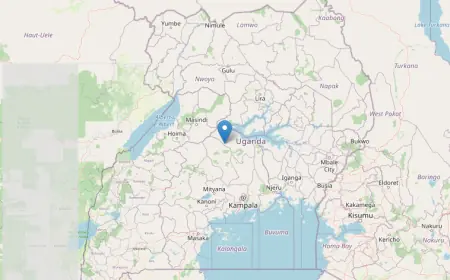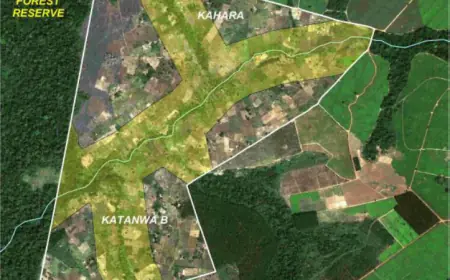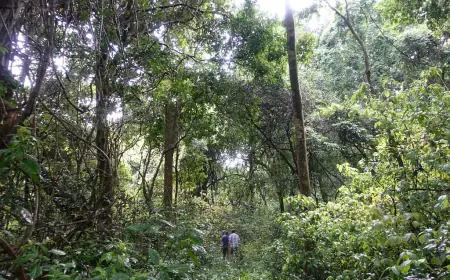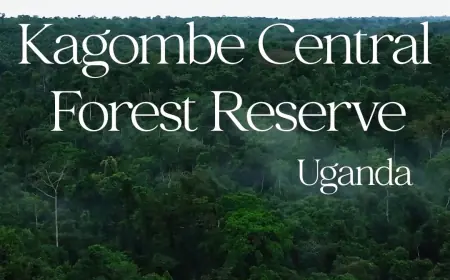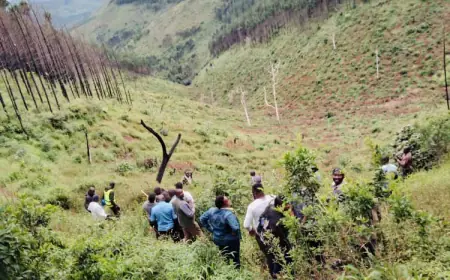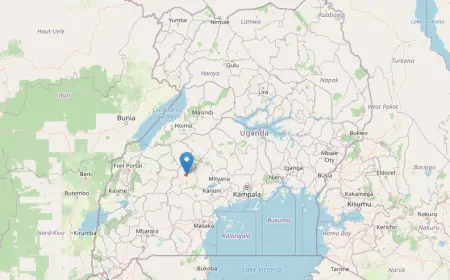Budongo Central Forest Reserve
Budongo Central Forest Reserve has a long and fascinating history, dating back to pre-colonial times.
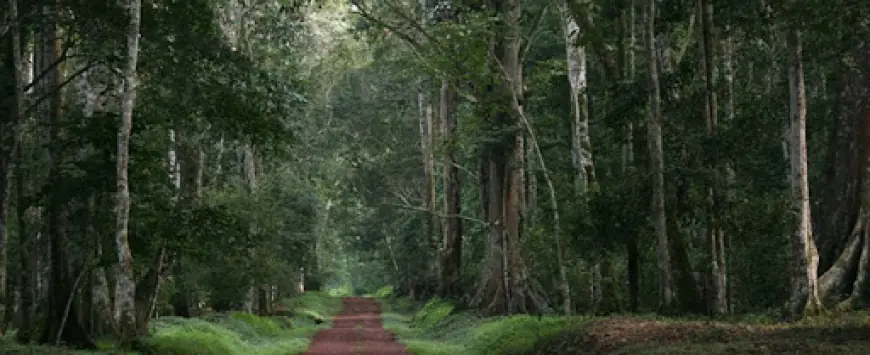
Imagine walking through a lush green forest, surrounded by the sounds of birds, monkeys, and insects. You feel a gentle breeze on your face and smell the earthy aroma of the soil and plants. You are in Budongo Central Forest Reserve, one of the most biodiverse and beautiful places in Uganda.
Budongo Central Forest Reserve is a tropical rainforest located in the western region of Uganda, within the Murchison Falls National Park. It covers an area of 435 km2, making it one of the largest forests in the country. It is home to a rich variety of wildlife, including 24 species of mammals, 9 species of primates, and over 360 species of birds. It is also known for its abundance of mahogany and ironwood trees, which are valuable for timber and furniture.
But Budongo is more than just a forest. It is a place of history, science, and conservation. It has been a site of human activity for centuries, from ancient kingdoms to colonial rule. It has been a focal point for primate research, especially on chimpanzees, which are the main attraction for many visitors. It has also faced various threats, such as illegal logging, poaching, and habitat loss, which have prompted collaborative efforts to protect and manage the forest.
In this article, we will explore the wonders of Budongo Central Forest Reserve and learn why it is a hidden gem of Uganda that deserves more attention and appreciation.
History of the Budongo Central Forest Reserve
Budongo Central Forest Reserve has a long and fascinating history, dating back to pre-colonial times. According to local legends, the forest was named after a powerful chief called Budongo, who ruled over the area and was buried in the forest. The forest was also a source of spiritual and cultural significance for the local people, who believed that it was inhabited by spirits and ancestors.
The forest was also a place of political and economic importance, as it was part of the Bunyoro-Kitara Kingdom, one of the most influential kingdoms in East Africa. The kingdom controlled the trade routes between the Great Lakes region and the Nile Valley and exploited the forest's resources, such as ivory, honey, and timber. The forest was also a battleground for several wars, such as the Bunyoro-Buganda wars, the Anglo-Egyptian wars, and the Kabalega resistance.
The forest's fate changed in 1932, when it was declared a Central Forest Reserve by the British colonial government. The main objective was to protect the mahogany and ironwood trees, which were highly valued for their timber and furniture. The forest was divided into six blocks, namely Siba, Waibira, Busaju, Kaniyo-Pabidi, Biiso, and Nyakafunjo, and was managed by the Forest Department.
The forest also became a site of scientific interest as researchers began to study the flora and fauna of the area. One of the most notable researchers was Vernon Reynolds, who established the Budongo Forest Project in 1990 and conducted extensive studies on the chimpanzees and other primates of the forest. He also founded the Budongo Conservation Field Station, which is a research and education center that hosts local and international scientists and students.
The forest also witnessed some of the major events in Uganda's history, such as its independence from Britain in 1962, the dictatorship of Idi Amin in the 1970s, and the civil war in the 1980s. These events had a negative impact on the forest, as it suffered from political instability, insecurity, and economic decline. The forest also faced increased pressure from the growing human population, which encroached on the forest's land for agriculture, settlement, and resource extraction.
Wildlife of Budongo Central Forest Reserve
Budongo Central Forest Reserve is a hotspot of biodiversity, hosting a wide range of plant and animal species. The forest is classified as a moist, semi-deciduous forest, which means that some of the trees shed their leaves during the dry season. The forest has four main vegetation types: colonizing forest, mixed forest, Cynometra forest, and swamp forest. The forest has over 465 species of trees, including the endangered mahogany and ironwood trees, which can grow up to 80 meters tall and 20 meters in circumference.
The forest is also home to 24 species of mammals, of which 9 are primates. The most famous and charismatic of these are the chimpanzees, which are the closest living relatives to humans. Budongo has one of the largest populations of chimpanzees in Uganda, with an estimated 600 individuals. The chimpanzees live in complex social groups and exhibit a range of behaviors, such as tool use, hunting, and communication. They are also very intelligent and curious, and they can recognize and interact with humans.
Other primates that can be found in the forest are the black-and-white colobus, the red-tailed monkey, the blue monkey, the olive baboon, the grey-cheeked mangabey, the vervet monkey, the potto, and the bushbaby. These primates are often seen in the canopy, feeding on fruits, leaves, and insects. They also play an important role in dispersing seeds and pollinating flowers, which helps maintain the forest's diversity and health.
The forest also hosts other mammals, such as the African buffalo, the bush elephant, the Uganda kob, the jackal, the bush pig, the giant forest hog, the duiker, and the pangolin. These mammals are mostly found on the forest edges and in savanna patches, where they graze on grasses and herbs. They are also preyed upon by predators, such as leopards, lions, and hyenas, which are occasionally seen in the forest.
The forest is also a paradise for birdwatchers, as it has over 360 species of birds, including some rare and endemic ones. Some of the notable birds are the Nahan's partridge, the yellow-footed flycatcher, the chocolate-backed kingfisher, the white-thighed hornbill, the crowned eagle, and the blue-breasted kingfisher. The forest also has a variety of other birds, such as woodpeckers, cuckoos, turacos, bee-eaters, sunbirds, weavers, and warblers. The forest's birds are often heard before they are seen, as they fill the air with their songs and calls.
The forest also has a rich diversity of other animals, such as reptiles, amphibians, insects, and spiders. The forest has 20 species of amphibians, such as frogs, toads, and salamanders, which are often found near streams and swamps. The forest also has 64 species of reptiles, such as lizards, snakes, and crocodiles, which are often seen basking in the sun or hiding in the foliage. The forest also has over 750 species of insects, such as butterflies, moths, beetles, ants, and termites, which are vital for the forest's ecology and food web. The forest also has over 280 species of spiders, some of which are venomous, such as the black widow and the brown recluse.
Conservation of Budongo Central Forest Reserve
Budongo Central Forest Reserve is a valuable natural resource, not only for its biodiversity but also for its ecosystem services, such as water regulation, soil protection, carbon sequestration, and climate moderation. The forest also provides livelihoods and income for the local people, who depend on the forest for firewood, charcoal, timber, honey, medicinal plants, and tourism.
However, the forest also faces various threats, such as illegal logging, poaching, mining, and encroachment. These threats have resulted in habitat loss, fragmentation, degradation, and biodiversity decline. The forest also suffers from invasive species, such as the Senna spectabilis tree, which outcompetes the native trees and reduces the forest's diversity and quality.
To address these challenges, various conservation efforts have been undertaken, involving different stakeholders, such as the government, the private sector, civil society, and the local communities. Some of these efforts are:
-
The National Forestry Authority (NFA), which is the government agency responsible for managing the forest, has implemented various measures, such as patrolling, law enforcement, boundary demarcation, and fire management, to prevent and control illegal activities and fires in the forest. The NFA also supplies tree seedlings to environmentalists and local people to plant in degraded areas and buffer zones to restore and enhance the forest's cover and connectivity.
-
The Budongo Conservation Field Station (BCFS), which is a research and education center, has conducted various studies on the forest's ecology, biodiversity, and socio-economics to generate scientific knowledge and inform conservation decisions. The BCFS also runs various programs, such as chimpanzee habituation, community outreach, environmental education, and eco-tourism, to raise awareness and support for the forest's conservation among the public and the local people.
-
The Jane Goodall Institute (JGI), which is a global conservation organization, has partnered with the NFA and the BCFS to implement the Budongo Forest Landscape Conservation Project, which aims to conserve the forest and its chimpanzees while improving the livelihoods and well-being of the local people. The project involves various activities, such as forest monitoring, chimpanzee health, community development, and sustainable agriculture, to achieve its goals.
-
The World Wide Fund for Nature (WWF), which is a global conservation organization, has supported the NFA and the BCFS to implement the Budongo-Semliki Landscape Project, which aims to conserve the forest and its ecosystem services while promoting sustainable development and livelihoods for the local people. The project involves various activities, such as forest governance, land use planning, climate change adaptation, and the green economy, to achieve its objectives.
These are some of the conservation efforts that have been undertaken to protect and manage Budongo Central Forest Reserve. However, more needs to be done, as the forest still faces many challenges and threats. The forest needs more funding, capacity, and collaboration to ensure its long-term survival and prosperity. The forest also needs more recognition and appreciation from the national and international community as a valuable natural and cultural heritage of Uganda.
Conclusion
Budongo Central Forest Reserve is a hidden gem of Uganda that offers a unique and diverse experience for nature lovers, researchers, and tourists. The forest is a treasure trove of biodiversity, history, and culture that showcases the beauty and richness of Uganda's natural resources. The forest is also a place of hope and inspiration that demonstrates the potential and possibility of conservation and development in harmony with nature and people.
Budongo Central Forest Reserve is a forest that deserves more attention and appreciation, as it is a forest that matters for Uganda and the world.
What's Your Reaction?
 Like
0
Like
0
 Dislike
0
Dislike
0
 Love
0
Love
0
 Funny
0
Funny
0
 Angry
0
Angry
0
 Sad
0
Sad
0
 Wow
0
Wow
0





























































